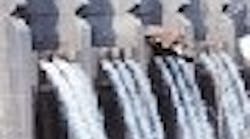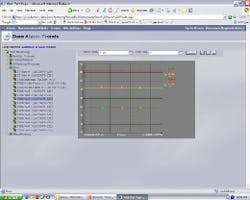The Greater Vancouver Regional District (GVRD) is in the quality-of-life business for our residents, overseeing aspects of drinking water, wastewater, air quality, social housing and parks. We arent after profitability; rather we are after reducing costs and improving how people live. Because of this, it was necessary for us to focus on building a sustainable region that could be maintained whether the population of the area stays at 2 million or grows to 3 million in the next 15 years, as is estimated.
To do this, we needed an enterprise-level data historian that would enable us to collect, analyze, report and integrate control system data and information to corporate systems and other lines of business. In 2005, we rolled the OSIsoft PI data collection and distribution engine into production. This gave us the foundation for successful enterprise business integration.
Business Challenges
The business challenges of creating a cohesive, working unit out of the GVRD was four-fold: dealing with disparate systems and data, replacing obsolete systems, preparing for ever-changing environments and acquiring real-time access to information across the organization. Each issue presented a separate set of challenges, solutions and benefits that were directly addressed by introducing OSIsofts technology and services.
GVRD manager, corporate applications, Gary L. S. Wong, says the OSIsoft data historian upgrade has speeded up GVRDs billing and receivables cycle, earning the company an additional $500,000 a year in interest.
The solution was as simple as adding just one OSIsoft PI V3.4 server to manage all control-system data. This allowed for a common user interface using the ProcessBook graphics module, the DataLink report creator and RtWebParts, which allows users to access information via the SharePoint Portal Server. In addition, users were able to access a web portal using Microsoft SharePoint across the entire organization. GVRD used MS BizTalk and the PI SDK software development kit for data and application integration, which simplified the entire process.
This simple implementation eliminated the need to standardize control or other disparate systems, saving hundreds of thousands of dollars. Deferring the replacement of our wastewater treatment plant control systems (which have a remaining product life of at least 10 years) will save $250,000 per year based on a cost of capital of 5%.
Employees now know where and how to find information, a change that can be felt across the organization. Our IT department fields fewer requests for tutorial and information. By using the OSIsoft platform, our organization only needed to learn one system that incorporated familiar Microsoft tools, making for faster implementation and adoption.
Replacing Obsolete Systems
Prior to implementing the OSIsoft solution, we had eight proprietary historians across four wastewater treatment plants (WWTPs). The organization was also facing imminent failure of an obsolete and cumbersome billing system responsible for managing $165 million per year in revenue from water sales and wastewater treatment. The billing system was not only out of date, but also slowa consistent two-month delay for the finance department to receive preliminary billing information caused internal and customer dissatisfaction. In addition, the billing system cost more than $100,000 a year for support and maintenance.
We replaced the system with PI redundant-pair buffer nodes at each of four WWTPs, sending data back to a single corporate OSIsoft PI server. The Corporate Historian Reporting and Information System (codename CHRIS) is based on PI Enterprise, PI SDK, .Net and Microsoft Office. In short, the entire billing application was rewritten with zero downtime on production systems and no lag. The move saved $285,000 on licensing fees alone. Support and maintenance costs are also projected to be reduced by 70%.
In addition, more than 100 GB of data needed for billing, previously stored in a Sybase system, was converted to just 6 GB in OSIsoft PI. This accelerated our data, and the finance department now receives billing information in near-real time, allowing for accurate budget forecasting and more accurate and faster billing. By speeding up our billing and receivables cycle by one month, were able to earn an extra $500,000 per year in interest. The organization also benefits, as quality assurance and quality control are no longer headaches, since all data is available in real time and includes an audit trail.
Preparing for Ever-Changing Environments
The SCADA system needed to be replaced by 2007/2008, and data continuity was needed for water distribution and wastewater collection. Water operations optimization also demanded simulations, forecasting and predictive modeling requiring operational and process data. The new water filtration plant also needs to be online in 2008 and ready for up to 40,000 new tags. Finally, OSIsofts solutions are based on the MS Office platform, and Office System 2007 was in pilot version, therefore the portal and desktop were evolving.
The solution was to go with OSIsofts PI Enterprise Corporate server, which is able to collect data from new control systems. All of the control system data resides in the OSIsoft PI Enterprise server and is available for existing and future modeling and forecasting.
By using this product, the current systems are fully scalable and future-proof. Thanks to the common interface between CHRIS, RtWebParts, DataLink and ProcessBook, we have enabled an agile environment.
Needing Real-Time Access and Self-Service
Finally, we required real-time access to information and self-service for all users. The goal was to increase ROI while understanding the reality that training and support only increase as user demand goes up.
What OSIsoft provided was on-site training sessions in the train the trainers model and computer-based training. All users went through hands-on training to facilitate easy adoption. The RtWebParts solution was also in production with a scalable vector graphics viewer available and was implemented quickly on all 1,200+ desktops. Separately, DataLink and ProcessBook were available on request.
The OSIsoft System at Work
Once we had these pieces in place, we were able to implement some impressive real-time monitoring solutions, such as our storm sewer overflow predictor (SSOP). Before the PI System, data was not easily accessible. What was available could only be viewed on one SCADA console, which severely limited our ability to act. Data and possible trends could not be analyzed effectively, as the program was not supported by Excel. This lack of information led to local problems. For example, on the north shore of Vancouver, overflowing storm sewers caused flooding in residential basements. The GVRD received calls after the overflow event after it was too late to open the valves.
With the PI System, we are able to get data very quickly and in real time and to be creative and efficient with its use, which is how the SSOP was born. Through DataLink and using a linear regression model, current flow data in Excel is compared to historical data to predict the probability of an overflow. The spreadsheet is then stored as an HTML file and made available to all necessary employees on the intranet. This has eliminated overflows and has greatly increased customer satisfaction. Marilyn Towill, GVRD senior project engineer, says, Ive been monitoring the SSO Predictor, and it gave me some comfort through the rainy holiday season knowing that no overflow was expected.
Similarly, another predictor forecasts wastewater overflow, which prevents raw sewage overflows, damage to the environment and fines to the GVRD, which can cost up to $1 million per violation.
Real-time data also drives the dam monitoring system, an advanced warning system to increase local residents safety in the event of a storm or unforeseen structural problem (See Figure 1 below).
FIGURE 1: FLOOD ALERT!
Once we had the OSIsoft PI system in place, we could calculate tags for alarm limits. This allowed alarm-limit history to be stored and trended along side monitored tags. These tags are now monitored by an email program that sends alerts when alarm limits are breached.
We plan to incorporate PI and related products in other arenas, including the ozonization plant, air quality monitoring and water filtration plant information. With the help of OSIsoft, the GVRD has been able to build and maintain a sustainable region, improving the quality of life in the greater Vancouver area.
| About the Author |
Latest from Home

Leaders relevant to this article:







